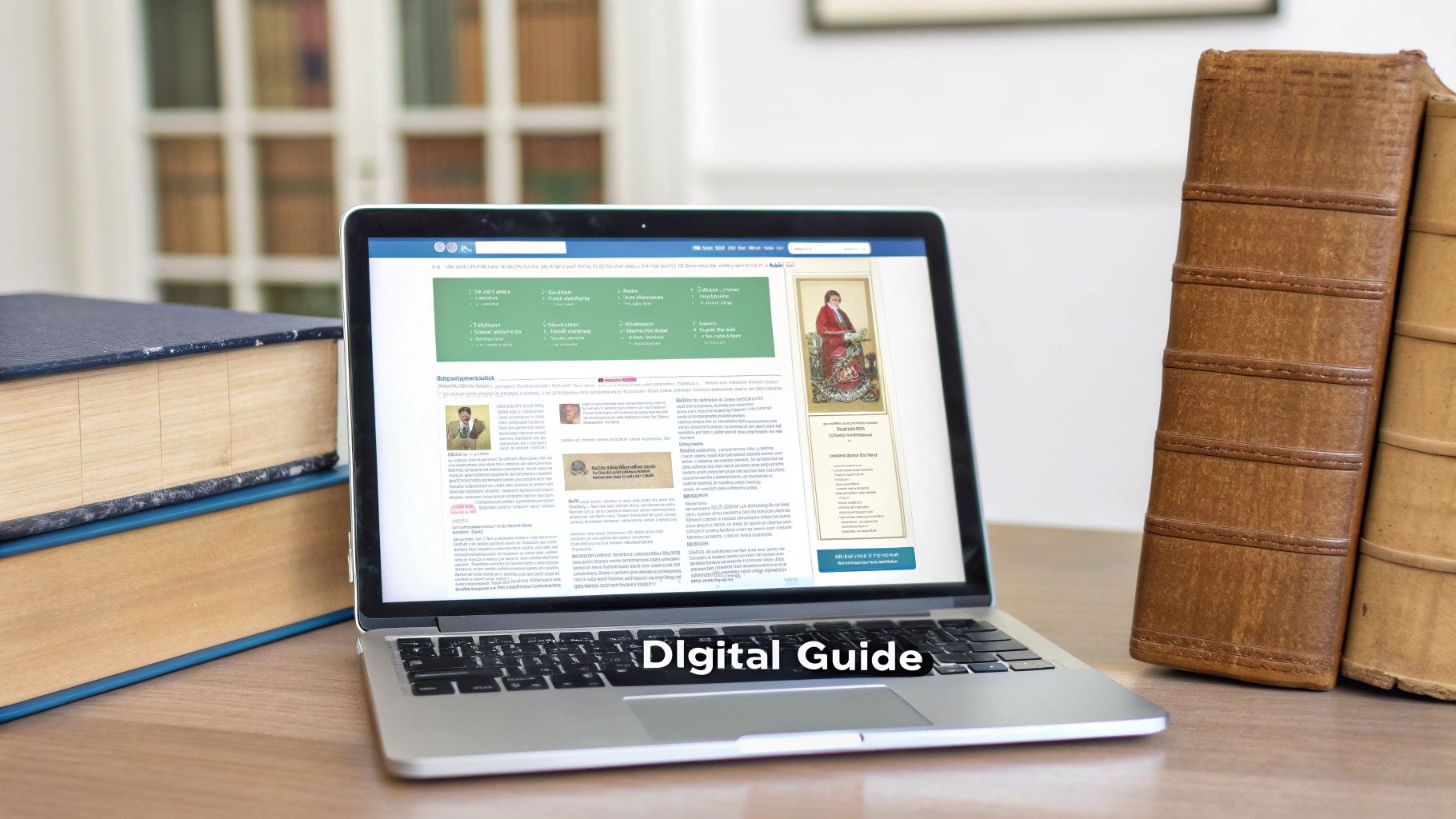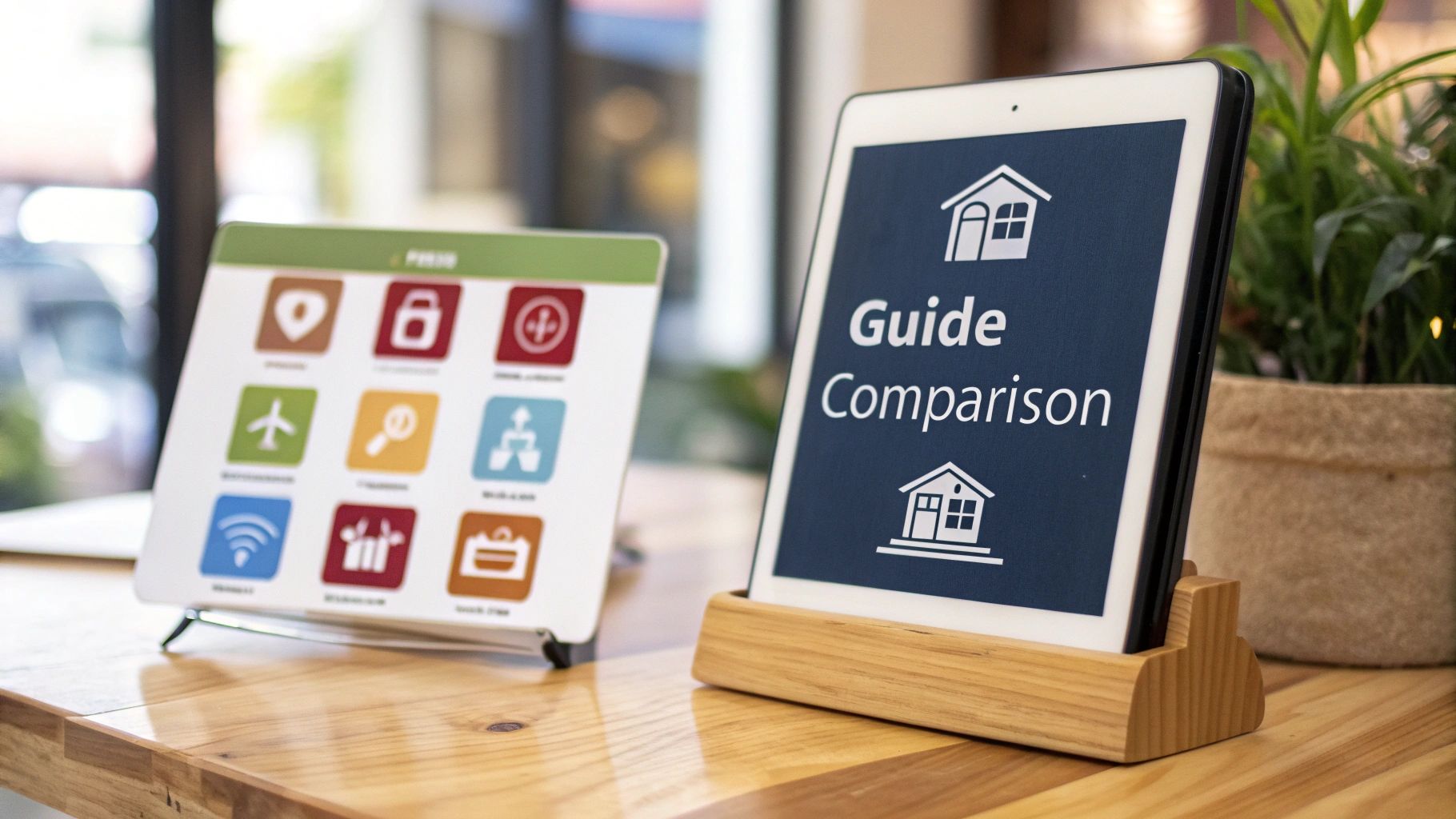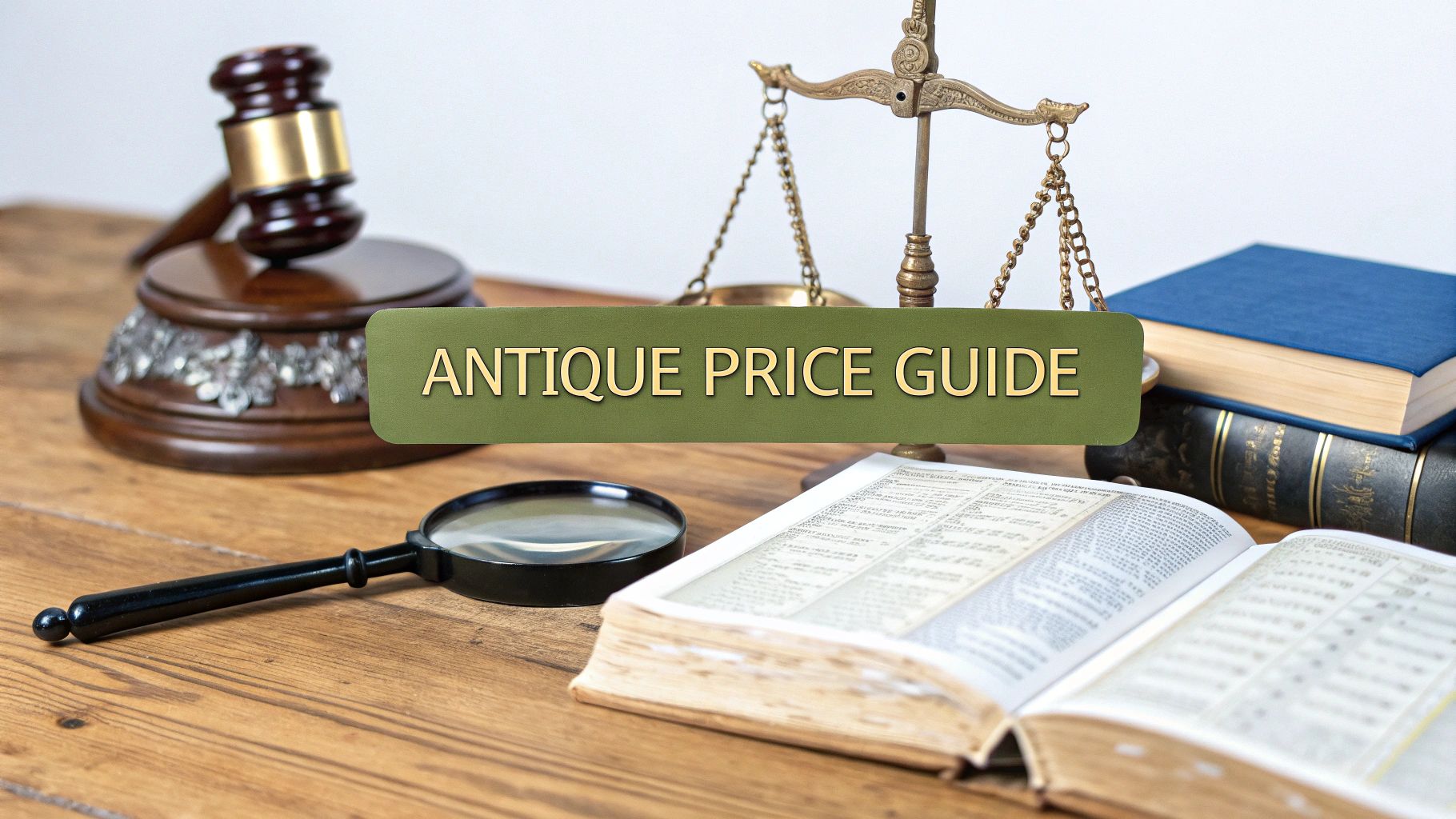Think of an antique price guide online as your personal market tracker for old and interesting things. It's a website or app that pulls together recent sales data from auctions, online marketplaces, and dealer inventories to show you what an item is actually selling for right now.
These digital guides have pretty much made the old-school print books obsolete. Why wait for a book that's already a year out of date when you can get instant access to up-to-the-minute pricing information? It's a game-changer for anyone interested in antiques, from casual collectors to serious sellers.
Your First Step in Online Antique Valuation

So you've found something you think might be valuable. What's next? An online price guide is your first and most important stop. It’s like a stock market ticker for your treasures, giving you a snapshot of an item's current worth based on real sales.
This is a huge leap forward from flipping through dusty, static price books. Those were great in their day, but today's online databases are constantly refreshed with the latest sales records. That means you're tapping into a massive, live pool of information, not just a single author's opinion from last year.
Why This Matters for You
Figuring out what something is worth is the critical first step, no matter who you are—a homeowner curious about an heirloom, a new collector, or a seasoned reseller. An accurate valuation changes everything, from setting a fair price at a garage sale to getting the right insurance coverage.
The advantages of going online are pretty obvious:
- Speed: You can find what you need in seconds, not hours.
- Accessibility: These massive databases are available anytime, right from your phone or computer.
- Accuracy: The values are based on what people are actually paying for items today, not just old estimates.
To see this in action, check out an online price guide for collectibles. Even though it's for baseball cards, the core idea is the same: using tons of sales data to pinpoint an item's true market value.
A quick note on terminology: An item is officially an antique if it's more than 100 years old. Anything younger than that (but usually over 20 years old) is considered vintage. Knowing the difference will help you search in the right places.
What You Will Learn Here
Think of this guide as your roadmap. We’ll walk through how to pick the right online tools and, just as importantly, how to make sense of the data you find. My goal is to give you the confidence to figure out the value of any antique you come across.
By the time you're done, you'll see that a price isn't just a number. It’s a story told by an item's history, condition, and the demand for it in today's market. Let's get started.
Why Digital Price Guides Are Now Essential

It wasn't that long ago that valuing an antique meant hauling a heavy stack of reference books off the shelf. You'd spend your afternoon flipping through page after page, squinting at photos to find a match, and just hoping the price printed last year was still in the ballpark.
Those days are pretty much over.
The antiques world has changed. It's now a fast-moving, global marketplace where information is everything and speed is what gets you the deal. Using an antique price guide online isn't just a neat trick for serious dealers anymore; it’s a must-have for anyone involved, from weekend flea market hunters to families tasked with sorting through a loved one's estate.
The reason is simple: the market itself now lives online. Buyers, sellers, and collectors are all connected, doing their homework, comparing prices, and making deals in real time. Trying to keep up using a print guide from 2022 is like showing up to a car race with a horse and buggy—you're just not built for the modern road.
The Problem with Print
Print guides were the Bible for decades, but their shortcomings have become impossible to ignore in today's market. A printed book is like a snapshot; it perfectly captures a single moment in time but tells you nothing about what happened five minutes before or five minutes after.
Relying on physical books today comes with some major drawbacks:
- Instantly Outdated: By the time a book is researched, edited, printed, and shipped, the market has already moved on. Prices for hot categories can swing wildly in a matter of months, making that printed value totally irrelevant.
- Limited Scope: A book only has so much space. It might show a few classic examples of a specific pottery style, but it can't possibly include the thousands of variations and real-world sale prices you’ll find in an online database.
- Clumsy Searching: To find anything, you usually need to know exactly what you're looking for—the maker, the pattern name, the right keywords. There's no way to search with a photo of a weird marking you found, which often leads to a dead end.
These aren't just minor inconveniences. They can cost you real money. Price an item too high, and it'll sit on the shelf gathering dust. Price it too low, and you've just given away a treasure.
An antique's value isn't a static number carved in stone. It's a living thing, influenced by recent auction results, collector trends, and even what’s popular on TV. Digital guides are the only tools that can track that constant motion.
The Digital Advantage
An online antique price guide, on the other hand, is more like a live video feed of the market. It’s always on, constantly updating, and searchable in ways a book could never be. This gives everyone, from novices to experts, a much clearer view of what's really going on.
You can't argue with the numbers. The global antique market is expected to hit $54.2 billion by 2025, and online sales are growing at an incredible 18% each year. On top of that, a whopping 68% of buyers now do their research online before they even think about making a purchase. You can read more about these antique marketing statistics to see just how much the industry has shifted.
This move to digital gives you some serious power:
- Access to Massive Databases: Online guides tap into millions of sales records from auction houses, marketplaces, and dealers across the globe. This gives you a much bigger, more accurate picture of what something is truly worth.
- Real-Time Auction Results: Many platforms show you what an item sold for yesterday, not what an editor guessed it was worth last year. Seeing recent, actual sale prices is the gold standard for valuation.
- Powerful Search Tools: Forget just typing in text. Now you can often search with a photo of the item, a snapshot of the maker's mark, or just a few descriptive words. It makes identifying those mystery pieces a whole lot easier.
At the end of the day, using an antique price guide online isn't just about being modern. It’s about making smarter decisions with the best information out there, so you know the true value of your treasures in today's market.
Comparing the Best Online Antique Price Guides

Choosing the right online antique price guide is a bit like picking the right tool for a job. You wouldn't use a sledgehammer to hang a picture frame, and you wouldn't use a tiny screwdriver to build a deck. Each tool has a purpose, and the same goes for these valuation platforms.
Some guides are massive, data-heavy beasts built for professional resellers who need to track market trends with precision. Others are more like digital libraries, perfect for digging into past auction results to verify an item's history and authenticity. And then you have the free options, which are fantastic for getting a quick, ballpark estimate on the fly.
Knowing the difference is what separates a frustrating wild goose chase from finding a resource that actually helps you. Whether you're trying to price a single family heirloom or you're managing a full-blown resale business, let's break down the options so you can pick the right one for your specific needs.
Feature Comparison of Leading Online Antique Price Guides
To give you a clearer picture, here’s a quick comparison of the most popular platforms. Think of this table as a "cheat sheet" to help you quickly match your needs with the right service.
| Platform | Pricing Model | Database Size | Key Features | Best For |
|---|---|---|---|---|
| WorthPoint | Subscription (monthly/annual) | Massive (billions of records) | Historical price trends, maker's marks library, vast image database. | Serious resellers, professional appraisers, and dedicated collectors. |
| LiveAuctioneers | Free to access archives | Large (millions of past lots) | Real-time bidding, expert auction house descriptions, high-quality photos. | Researchers tracking auction results and buyers looking for verified items. |
| Invaluable | Free to access archives | Large (millions of past lots) | Access to premium auction houses, price estimates, detailed provenance. | Collectors focused on high-end art, antiques, and decorative arts. |
| Kovels | Free (with premium options) | Moderate (hundreds of thousands of items) | Free price lookups, identification guides, articles, and collector resources. | Beginners, casual sellers, and anyone needing a quick, reliable estimate. |
This table is just a starting point, of course. The real value comes from understanding how each platform works in practice and which one aligns with the kind of research you do most often.
Subscription Powerhouses: WorthPoint
When you need sheer, unadulterated data, WorthPoint is the undisputed king. Think of it as the ultimate encyclopedia of sold items. It scrapes sales data from hundreds of auction houses and online marketplaces (including eBay) to create a colossal, searchable database of what things have actually sold for.
This is the go-to tool for serious resellers and collectors who need a complete sales history. Its main feature, the Price Guide, has billions of entries, letting you see not just what an item sold for, but how its value has trended over years across different venues. It’s incredibly powerful.
But all that power comes at a price. WorthPoint is a subscription service, and its interface can be a little intimidating for newcomers. It’s really built for people who are doing in-depth research regularly and can justify the monthly fee with their buying and selling. Digging into the different price guides for antiques can help you decide if a premium service like this is the right fit.
Auction Archives: LiveAuctioneers and Invaluable
Platforms like LiveAuctioneers and Invaluable are interesting because they wear two hats. First, they are active marketplaces where you can bid on items in real time. Second, their archives of past auctions are a goldmine for valuation research.
Think of these sites as a library of old auction catalogs. You can search for something specific, like a "George Jones & Sons coffee pot," and see every time a similar piece has been sold on their platform. You get high-quality photos, detailed descriptions from auction specialists, and the final hammer price.
The big advantages of using these auction archives are:
- Expert Descriptions: Items are usually cataloged by professionals who provide crucial details about origin, age, and condition.
- Real-World Prices: You’re seeing what a real person was willing to pay for something in a competitive auction.
- High-Quality Imagery: Auction listings almost always include multiple, high-resolution photos from every angle.
The only catch is that the data is limited to sales that happened on their specific platform. It’s extensive, but it won’t include sales from smaller auction houses, eBay, or private dealers.
A key takeaway here is to always cross-reference. An item's value can swing dramatically based on the auction house, the bidders in the room that day, and even the quality of the listing itself.
Free Resources and Niche Guides
Not everyone needs to pay for a subscription to find what an antique is worth. There are some fantastic free and specialized guides that provide solid information, especially for common collectibles or when you're just starting your research.
Kovels is one of the most trusted names in the antiques world; they've been publishing price books for decades. Their website offers a free price guide with hundreds of thousands of listings. It’s not as deep as a paid service, but it’s an amazing starting point for identifying an item and getting a ballpark value.
You'll also find niche guides for almost any category imaginable. For instance, if you collect vintage Pyrex, a dedicated collector's blog might have far more detailed information on rare patterns and pricing than a general guide. These focused sites are invaluable when you need to go deep on a specific subject.
Ultimately, getting a complete picture of an item's value often means using a mix of these tools. You might start with Kovels to identify an object, jump over to an auction archive to see recent sales, and then, if it’s a high-value piece, cross-reference it on WorthPoint to understand its long-term market performance. This layered approach is the surest way to get an accurate and well-rounded appraisal.
How to Research Antiques Like an Expert

Having a top-notch antique price guide online is a great first step, but it’s really only half the battle. Think of it like this: you can have the best fishing rod in the world, but if you don’t know where the fish are biting or what bait to use, you’re coming home empty-handed. Let's walk through how to research like a seasoned pro, turning raw data into a valuation you can trust.
This isn't about guesswork. It's about a systematic approach. By breaking your research into a few clear, manageable steps, you can take a mysterious old object and turn it into a well-understood treasure with a real-world market value. We’ll cover the essential techniques, from the initial detective work to making sense of all the pricing data.
Step 1: Start with Identification
Before you can even think about looking up a price, you have to know what you’re looking at. This is the fun part—the detective work. Get your item into a well-lit space and really give it a thorough, hands-on examination.
Your single most important clue is almost always the maker's mark. This could be a tiny stamp, a signature, or a symbol that tells you who made the piece. On ceramics, flip it over; you'll usually find the mark on the bottom. For furniture, check the back, inside drawers, or even for a small paper label.
These marks are the fingerprints of the antique world. Some are simple initials, while others might be elaborate crests. Many online price guides have entire libraries dedicated to helping you identify these symbols, which is an invaluable place to start.
A quick pro tip: take a crystal-clear, high-resolution photo of any marks you find. Bad lighting or a blurry shot can send you on a wild goose chase, especially if you plan on using an image search tool to help out.
If you don't find a mark, don't worry. You just have to look at other details:
- Materials: Is it oak, mahogany, or pine? Porcelain or earthenware? The materials themselves tell a story about the item’s age and origin.
- Construction: How was it put together? Are the furniture joints handmade dovetails, or were they machine-cut? Can you see saw marks or signs of hand-planing?
- Style: Does the design scream Art Deco, Victorian, or Mid-Century Modern? Nailing the style helps you zero in on the time period it was made.
If you're still feeling stuck, modern technology can give you a real leg up. Using an antique identification app can provide that initial breakthrough you need. Just by analyzing a photo, it can often give you instant context about where your item came from and its history.
Step 2: Craft Smart Search Queries
Once you’ve gathered your clues, it’s time to head to your chosen online price guide. The quality of what you find is directly tied to the quality of your search terms. A vague search like "old wooden chair" will flood you with millions of useless results.
The trick is to combine all the little details you’ve collected into a specific, descriptive search phrase. You need to think like a cataloger, using keywords that highlight the most unique features of your piece.
Here’s how you can build a smarter search:
- Start with the Maker: If you found one, lead with it (e.g., "Johnson Bros ironstone").
- Add the Object Type: Be specific (e.g., "Johnson Bros ironstone platter").
- Include the Pattern or Style: If you know it, add that in (e.g., "Johnson Bros Heritage pattern platter").
- Use Descriptive Adjectives: Toss in details about size, color, or shape (e.g., "large oval Johnson Bros Heritage platter").
By layering keywords like this, you systematically filter out the noise, leaving you with listings that are a much closer match to your piece. It’s a targeted approach that saves a ton of time and makes your results far more accurate.
Step 3: Understand Different Types of Value
One of the most confusing things for newcomers is seeing drastically different prices for what looks like the same item. You might find a vase listed for $50 on eBay, but then see a similar one sold for $250 at a major auction house. This doesn't mean the data is bad; it just means you're looking at different types of value.
Getting a handle on these distinctions is absolutely critical for an accurate appraisal. Here are the three main values you'll run into:
- Auction Price (or "Hammer Price"): This is what an item actually sold for in a competitive bidding situation. It’s a great reflection of true market value on a given day, but remember, it doesn’t include the buyer's premium (the extra fee the winner has to pay).
- Retail Value (or "Dealer Price"): This is what you’d expect to pay for the item in an antique shop. It’s naturally higher than the auction price because it has to cover the dealer's overhead, expertise, and, of course, their profit.
- Insurance Value (or "Replacement Value"): This is the highest figure of all. It represents what it would cost to buy that exact item again from a retail source, right now. It is almost always more than what you could sell the item for.
When you're doing your research, pay the closest attention to recently sold auction prices from several different sources. This is the purest form of market data because it shows what real people are actually willing to pay for an item today. A solid final appraisal comes from looking at all these values together to get a well-rounded picture.
Understanding What Really Drives an Antique's Value
Ever wonder why one dusty chair from an attic is worth $50, while another that looks almost identical sells for $5,000 at auction? The secret isn't just about age. An antique price guide online is a brilliant tool for seeing what things are selling for, but learning to read between the lines is what separates the casual browser from the savvy collector.
Think of yourself as a detective. The final price tag is just the last page of the story. The real work is in uncovering the clues that led to it. Four key factors almost always determine an antique's value, and once you get a feel for them, any price guide becomes infinitely more useful. These are the pillars of valuation: Rarity, Condition, Provenance, and Desirability.
Rarity and Condition: The Foundational Twins
Rarity is pretty straightforward. The fewer of something there are, the more people will want them. If a potter made only ten unique vases before their studio tragically burned down, those ten pieces will always be more valuable than the ten thousand stamped out by a factory. It's classic supply and demand.
Condition, however, is the great equalizer. Even the rarest object on earth will lose its value if it’s in shambles. Think of an item’s condition as a multiplier. A piece in mint or near-mint shape might fetch 100% of its potential price, but the same item with a nasty crack or a clumsy repair could plummet to just 20-30% of that value.
When you're inspecting a piece, keep an eye out for:
- Originality: Are all the parts original? A period-correct replacement is one thing, but a modern screw on a 19th-century cabinet is a red flag.
- Damage: Scan for chips, cracks, stains, or deep scratches that ruin the piece's aesthetic.
- Repairs: Look closely. A masterful, almost invisible repair is worlds away from a sloppy glue job.
A rare 18th-century chair in perfect condition is a treasure. That same chair with a broken leg and a modern screw holding it together is often just a project. Condition is non-negotiable for serious collectors.
Provenance: An Item's Backstory
This is where things get really fun. Provenance is simply an item’s documented history—its life story. It answers the big questions: Who owned it? Where has it been? Was it part of a famous collection or a historic event?
Think of provenance as an antique's celebrity connection. A standard pocket watch might be worth $200. But if you have paperwork proving that very same watch belonged to a well-known historical figure, its value could leap into the thousands. That story adds a layer of significance that collectors will happily pay a premium for.
Desirability: Riding the Wave of Trends
Finally, we have desirability, which is all about what’s hot right now. This is the most unpredictable of the four pillars because it's tied directly to trends and popular taste. What collectors were chasing 30 years ago might sit on a shelf today, and vice versa.
A great example is the current surge in interest among younger buyers for sustainable, unique home decor. Many are now choosing well-made, historic furniture over cheap, mass-produced items. This isn't just a passing fad; it's a genuine market shift. The online resale market for furniture—a huge antiques category—hit an incredible $34 billion in 2023 and is on track to reach $56 billion by 2030. This growth, powered by new digital platforms and a fresh generation of buyers, shows a real move toward investing in pieces with soul and staying power. You can read more about what's next by exploring the future of the antiques market on ronati.com.
By getting a handle on these four drivers—Rarity, Condition, Provenance, and Desirability—you’ll have the context you need to truly understand the numbers you see in an online price guide. You won't just see the price; you'll see the story behind it.
Don't Ditch Your Old Price Books Just Yet
It’s tempting to think that with all the amazing online antique price guides available, those heavy, old-fashioned price books are just gathering dust. But tossing them out would be a big mistake. The smartest collectors and dealers know how to use both, blending the instant access of digital tools with the deep wisdom found in print.
Think of it like this: an online guide is your up-to-the-minute stock ticker, showing you what an item is selling for right now. A classic price book, on the other hand, is like the company's annual report. It gives you the history, the context, and the expert analysis to understand why that price is what it is.
The Timeless Power of Print
Printed price guides can't give you real-time sales data, but they offer something just as valuable—a solid foundation of knowledge. They’re perfect for when you’re just starting your research on a new find.
Here’s where printed guides really shine:
- Deep Historical Context: Books have the space to tell you the story behind a manufacturer, the importance of a certain style, or the history of a collection. This adds incredible depth to your valuation.
- Expert Curation and Commentary: The information in a good guide is put together by experts who've spent their lives in the field. They offer insights on quality, rarity, and those tiny details that raw data alone simply can't capture.
- High-Quality Visuals: A well-made book is packed with crisp, detailed photos. They are fantastic for comparing maker’s marks, patterns, and construction details right next to your item.
Guides like the 'Antique Trader Antiques & Collectibles Price Guide' are still a gold standard for a reason. They offer thousands of photos and expert analysis that provide an incredible starting point for any appraisal.
Building Your Hybrid Valuation Strategy
So, how do you actually make this work? It’s a simple two-step dance between the old and the new.
First, use the book to identify what you have and learn its story. Then, jump online to find out what it’s worth today.
Start by grabbing your physical guide. Use it to identify your item, learn about its maker, and understand what makes it special. Once you’ve got that solid base of knowledge, you'll know exactly what keywords and details to look for.
Now, take that information to your favorite online price guide. This is where you’ll find the recent, comparable sales data that tells you what similar items are actually selling for in the current market. You can explore more about the nuances of pricing for antiques in our guide.
By combining both, you create a valuation that’s backed by hard data and informed by historical context and expert knowledge. It’s the surest way to arrive at the most accurate appraisal possible.
Got Questions About Online Valuations? We've Got Answers.
Stepping into the world of online antique price guides can feel a bit like learning a new language. You're bound to have questions, from how much you can trust the numbers to why prices seem to be all over the place. Let's clear up a few of the most common head-scratchers.
A big one is always, "Just how accurate are these online valuations?" The short answer is: it really depends. The best platforms pull their data from millions of real-world, recent sales results. If a guide is based on actual sold prices, it's giving you a pretty solid snapshot of the current market. But remember, the valuation you get is only as good as the information you put in. A perfect identification is the first step to getting an accurate price.
Why Do Prices for the Same Item Swing So Wildly?
If you've spent any time browsing, you've seen it: the same antique listed for a handful of different prices, sometimes with huge gaps between them. This isn't a mistake; it's just how the antique market works. Several key factors are at play.
- Condition is King: This is the golden rule. A piece in mint condition will always be worth more—sometimes vastly more—than one with even minor damage like chips or cracks. A small flaw can easily slash the value by 50% or more.
- Where It's Sold Matters: Think of it like real estate: location, location, location. An item sold at a prestigious auction house will almost always command a higher price than the exact same piece at a local flea market or on a site like eBay.
- A Good Story Sells: This is what collectors call provenance. An object with a documented history, especially one tied to a famous person or a significant event, can be worth a fortune compared to an identical one with no backstory.
The price you see is just a snapshot in time. It's what one buyer was willing to pay for that one item, in its specific condition, on that particular day.
In the end, the smartest move is to look at several sources. When you compare the sold prices from auction records, what dealers are asking, and the data in a good price guide, you start to see a realistic value range emerge. It’s this multi-layered approach that irons out the price wrinkles and gives you a valuation you can actually trust.
Uncover the history and value of your treasures in seconds. With the Curio app, you can snap a photo to instantly identify antiques, get an estimated appraisal, and explore their fascinating stories. Download Curio today and let your antiques talk. Learn more at https://www.curio.app.
